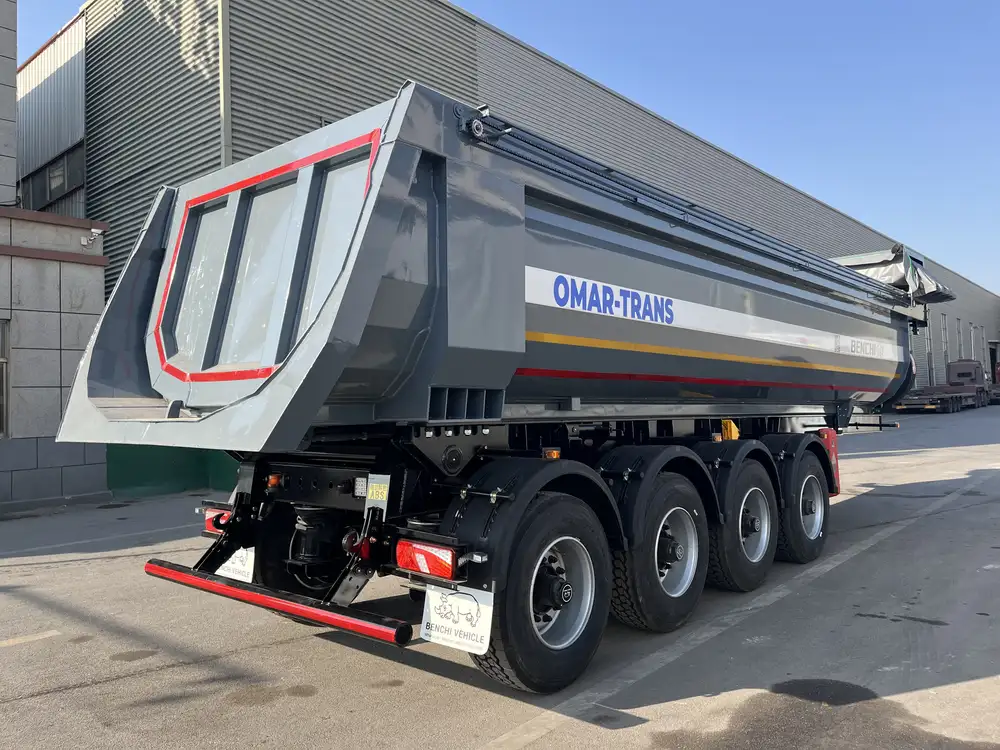Semi-trailers are a cornerstone of modern logistics and transportation, facilitating the movement of goods across vast distances. At the heart of these trailers lies a crucial yet often overlooked component: the stands. This article delves into what stands are and their significant importance in the context of semi-trailers.
What Are Semi-Trailer Stands?
Semi-trailer stands, commonly referred to as landing gear or support legs, play a pivotal role in the functionality and safety of semi-trailers. These are the mechanical devices located at the front of the semi-trailer that bear the weight of the trailer when it is unhitched from the tractor unit. Below, we explore the various types and features of these stands, illustrating their significance in the transportation ecosystem.
Types of Semi-Trailer Stands
Manual Landing Gear
- Operation: This type requires the operator to manually crank a handle to raise or lower the legs.
- Advantages: Simplicity in design leads to fewer mechanical failures.
- Disadvantages: Labor-intensive and time-consuming, especially in high-volume operations.
Power-Driven Landing Gear
- Operation: Uses hydraulic or electric mechanisms to adjust the height of the stands.
- Advantages: Eases the process significantly, allowing for quicker hook-ups and disconnects.
- Disadvantages: Higher initial cost and potential for hydraulic failure.
A-Frame Stands
- Operation: Features a triangular design for distributing weight more evenly that enhances stability even on uneven terrains.
- Advantages: Superior support, with an increased load-bearing capacity.
- Disadvantages: Heavier than standard designs.
Slide-Out Stands
- Operation: Extend outward from the trailer for stability.
- Advantages: Good for uneven surfaces, enhancing the overall stability of the trailer.
- Disadvantages: May require more space for deployment.

Key Components of Semi-Trailer Stands
| Component | Description | Benefit |
|---|---|---|
| Legs | Vertical supports that bear the trailer’s weight | Crucial for safety when detaching |
| Cross-Member | A reinforcing brace that connects the legs | Provides additional stability |
| Crank Handle | Manual control for adjusting height | Control over the extension and retraction |
| Support Pads | Feet that contact the ground | Disperse weight and prevent sinking |
Understanding how each of these components functions independently and collectively is vital for improving the durability and performance of semi-trailer stands.
Importance of Stands in Semi-Trailer Safety
Stability and Balance
When cargo weights fluctuate or when the trailer is parked on an incline, the quality and design of the stands become essential. A robust and properly maintained stand system will ensure that the trailer does not tip over or shift unexpectedly, which can lead to accidents or cargo damage.

Load Management
Optimally functioning stands help in distributing the weight of the loaded trailer. Correct weight distribution is critical; it impacts how the trailer tows and prevents tires from wearing unevenly. A malfunctioning stand can lead to excessive sway or poor handling while in transit.
Enhanced Operational Efficiency
In an industry where time equals revenue, efficient setups become paramount. Designed for convenience, power-driven stands can reduce the time it takes to detach and attach trailers, optimizing workflow in transit yards.
Maintenance Tips for Semi-Trailer Stands
Regular maintenance can significantly extend the lifespan of semi-trailer stands, ensuring they function properly and safely. Here are essential tips:

Inspect Frequently
Carry out visual inspections regularly for any signs of wear, including:
- Rust or corrosion
- Cracks or bends in material
- Fluid leaks in hydraulic systems
Lubrication Schedule
For manual landing gear, proper lubrication is essential to keep the crank handle operating smoothly. For power-driven stands, ensure hydraulic fluid levels are adequate and check for potential leaks.
Replacement of Worn Parts
Components such as crank handles, screws, springs, and pins should be replaced at the first sign of wear. Ignoring minor issues can escalate into major hazards on the road.

Troubleshooting Common Issues with Semi-Trailer Stands
Jamming Crank Handle
A common inconvenience faced by operators is when the crank handle jams. This typically occurs due to debris or lack of lubrication. Here’s how to troubleshoot:
- Clear Obstructions: Inspect the gear assembly for debris and clean as necessary.
- Lubricate: Apply lubricant to the moving parts and reattempt to operate.
Irregular Height Adjustment
When stands do not adjust evenly, this can signify a malfunction.
- Check the Mechanism: Inspect both legs for damage and misalignment.
- Hydraulic Issues: In the case of hydraulic systems, look for leaks and ensure the hydraulic fluid is at appropriate levels.

Stability Concerns
If the trailer feels unstable when parked:
- Inspect Support Pads: Ensure they are placed properly and make contact with the ground.
- Evaluate Load Distribution: Analyze the weight distribution of the cargo and adjust as necessary for optimal balance.
Conclusion: The Unsung Heroes of Semi-Trailers
While they may not always be at the forefront of discussions concerning transportation logistics, semi-trailer stands are integral to the safety and efficiency of hauling goods. Through understanding what stands are, their types, components, maintenance needs, and troubleshooting strategies, operators and companies can enhance their operational capacities significantly.
By focusing on these crucial components, businesses can optimize their semi-trailers, minimize downtime, and ultimately improve the bottom line. For manufacturers and logistics companies, investing in high-quality stands—whether manual or power-driven—should be a priority. Moreover, prioritizing regular maintenance and prompt repairs can lead to a safer and more productive operation.



